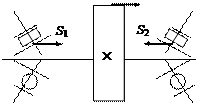Let us analyze the rolling contact bearings for strength. Initial dates are:
– type designation of the bearing and its sizes (# and d × D × B);
– rotational speed n of the bearing inner ring;
– components of reacting forces in supports RxA, RyA, RxC, RyC and RzA;
– basic load rating Cr and static load rating C 0 for radial ball bearings and angular-contact bearings with pressure angle α≤18º (tables 9.3 and 9.4);
– basic load rating Cr and axial load parameter e for angular- contact bearings with pressure angle α>18º (tables 9.4 and 11.1);
– basic load rating Cr, axial load parameter e and axial load factor Y for tapered roller bearings (table 9.5).
In our case for the output shaft we will use angular-contact boll bearings 36214 (70×125×24); n = 93.6 rpm; RxA = 7491.5 N,
RyA = 36.26 N, RxC = 9835.5 N, RyC = 861.74 N and RzA = Fa = 346.7 N;
Cr =80.2 kN, C 0 = 54.8 kN.
11.1. Determine the total radial reacting forces which act to the bearings
 ;
;  .
.
11.2. Determine the total axial forces acting to the bearings
11.2.1. Calculate additional axial forces S 1 and S 2 that develop as a result of action of radial forces Fr 1 and Fr 2
S 1 = Fr 1× e’; S 2 = Fr 2× e’,
where – e’=e for radial ball bearings and angular contact ball bearings;
e’ =0.83× e for tapered roller bearings.
It is necessary to note that for radial ball bearings and angular contact ball bearings with pressure angle α≤18º axial load parameter e is determined by table 11.1 depending upon ratio Fa/C o.
In our case Fa/C o = 346.7/57800 = 0.006; e’=e = 0.3 (table 11.1); S 1 = Fr 1× e’= 7491.6∙0.3 = 2247.5 N; S 2 = Fr 2× e’ = 9870.2∙0.3= 2961.1 N.
|
 | |||||||
 | |||||||
 | |||||||
 | |||||||
Fig. 11.1. Forces acting to the shaft in the axial direction.
 2015-08-21
2015-08-21 309
309








